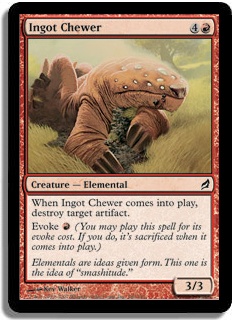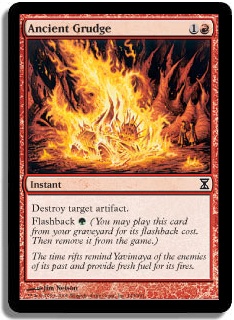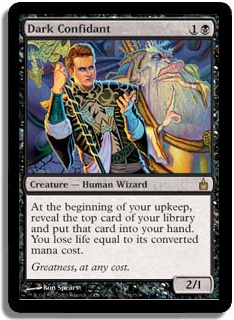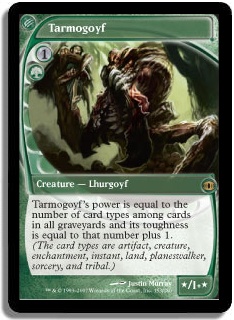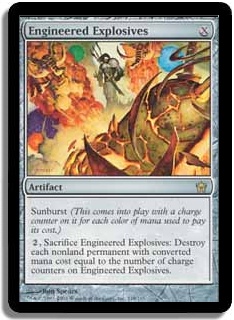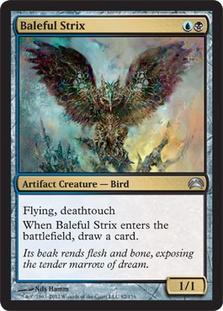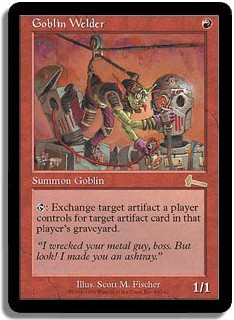In last week’s installment of Vintage Avant-Garde, I took a break from talking about Magic’s oldest format to discuss my new pet format The Danger Room. A link to that article can be found here.
After three weeks deep in the tank training rigorously in The Danger Room, it’s finally time to reemerge from that place and return to the world of Vintage, though hopefully with new perspective and zeal from having had the experience. Having taken an article off from reporting on Vintage to talk about Zodiac Roosters and Urborg Volcanoes, this week’s offering thus has a month’s worth of information to be observed and thought about since I wrote about Vintage last.
Summer has traditionally been the big season for Vintage play, especially in June-July leading up to the Vintage Championship. Today’s article is going to cover a little bit of everything:Â news, results, technology, and prediction. Basically, a little bit of everything that any Vintage ringer should be aware of as they begin their summer campaign of planeswalker battling.
The Bazaar of Moxen
Last month marked the sixth annual Bazaar of Moxen tournament, which took place in Annecy, France. The Bazaar of Moxen tournament is significant because not only is it the largest non-proxy Vintage tournament on the planet, but it is the biggest Vintage tournament of the year period. The tournament drew 337 players to compete for a figurative infinity of sweet prizes including a cache of Power 9 and dual lands.
Creatures (25)
Lands (16)
Spells (19)
Sideboard

Yet again, the Dredge archetype proves that it simply has a knack for taking down big tournaments—first the 2011 North American Vintage Championship, and now the Bazaar of Moxen.
Hegemann’s Dredge list is notable for a few reasons that are worth paying attention to, whether you are playing in Europe, North America, or South America. First, his list is not the traditional manaless build, as he plays twelve lands capable of producing mana. I know that moving toward being able to cast spells has been the recent trend, but Mana Dredge’s success here on the biggest stage against the largest field should cement this theory into law moving forward.
The other thing that is smart about Erik’s deck is that he is packing the full suite of artifact removal in the maindeck and plans to cast it!
"Dredge has more artifact hate in the maindeck than most decks have after sideboard!?"
Four Ingot Chewer’s and an Ancient Grudge and lots of ways to cast these spells provides Dredge with a ton of ways to answer pesky artifacts—particularly from Workshop decks. The other thing that is cool about playing Ingot Chewer is that when he gets evoked, he goes to the graveyard and triggers Bridge from Below. With this in mind, he’s basically a red mana for a Shatter (that doesn’t get stopped by Thorns of Amethyst) that makes a couple of 2/2 Zombies. It’s a pretty savage piece of technology for necromancers and graveyard mages everywhere!
In light of Dredge winning yet another large-scale event, I am apt to believe that in most cases it is true that the larger the field, the better Dredge has the ability to be as a deck choice. First, the larger the event, the smaller the percentage of the field Dredge tends to make up, which makes it less and less justifiable to play more Dredge hate—which clearly works to the Dredge player’s advantage. Since Dredge won yet another 100+ player Vintage event, I believe the following statement to be true:
The larger the expected turn out of an event, the greater the number of anti-graveyard cards people should be playing in their 75.
I also think that, especially given the success of Dredge at the last Vintage Championship and now at the Bazaar of Moxen, that more and more savvy players will take note of the fact that Dredge seems like a strong choice for big tournaments. This could in turn lead to Dredge making up a higher than usual percentage of big events than has traditionally been true.
In particular, I am thinking about trends that are going to lead up to the North American Vintage Championship later on this summer, where I am beginning to suspect that Dredge (also because it is the cheapest deck to build without proxies) may very well represent an uncharacteristically high proportion of the metagame.
When I play Vintage tournaments, I am always in the highest percentile for cards that interact with the graveyard in any given field; however, if I felt like seven sideboard cards for Dredge (4 Leyline of the Void, 2 Nihil Spellbomb, and 1 Yixlid Jailer) was adequate in a tournament where the expected turn out was 35 players, going into a tournament where I am expecting more than 100 players I think playing 8 or 9 cards might be more prudent.
"MTG’s greatest Wizard was out in force at BOM: VI. 16 copies in the top 9 decks!"
As our Vintage landscape continues to shift away from a world presided over by Yawgmoth and his obnoxious Will into a world where efficient monsters dominate the battlefield, Dark Confidant’s Vintage stock continues to climb.
Bob Maher found himself being played in a variety of archetypes ranging from control to beatdown to tempo control, and importantly, I think this is a trend that will continue to be popular in the months to come. The Bob trend is an oversight of sorts; when Dark Confidant is ‘in favor’ almost every blue deck plays four copies, and when he ‘falls out of favor’ only roughly half the blue decks play four copies!
I think that the most important thing to understand about Dark Confidant right now is that he seems to once again be the preferred lynchpin for the control decks. Every BUG Fish deck is going to run four Dark Confidant; that’s a given. However, the majority of Yawgmoth’s Will decks are opting to draw their cards with Confidant, which is interesting and significant. It isn’t the first time this has been true, and it certainly won’t be the last time.
"The Three Amigos."
I expect to see a lot of this creature configuration putting pressure on the opposition over the summer. Whether or not Delver of Secrets will join the fiesta is yet to be determined. It would be difficult to make a list of the best creatures in Vintage where these creatures are right up at the top together (along with Lodestone Golem and Qasali Pridemage). It’s simply a matter of getting to play with all the best, most efficient creatures in Vintage.
Creatures (12)
Planeswalkers (1)
Lands (15)
Spells (32)
- 1 Brainstorm
- 1 Vampiric Tutor
- 1 Mystical Tutor
- 1 Yawgmoth's Will
- 4 Force of Will
- 1 Sol Ring
- 1 Demonic Tutor
- 1 Hurkyl's Recall
- 1 Time Walk
- 1 Ancestral Recall
- 1 Mana Crypt
- 1 Time Vault
- 1 Merchant Scroll
- 1 Tinker
- 1 Voltaic Key
- 1 Black Lotus
- 1 Mox Emerald
- 1 Mox Jet
- 1 Mox Pearl
- 1 Mox Ruby
- 1 Mox Sapphire
- 1 Ponder
- 3 Preordain
- 2 Mental Misstep
- 2 Flusterstorm
Sideboard

The Bazaar of Moxen BUG deck is different from most of the BUG lists I’ve seen, because it simply doesn’t Gush. However, it still does a lot of other powerful things—mainly, it plays all the best creatures and disrupts the opponent with permission.
I would assume this to be the template for BUG Fish decks without Gush + Fastbond moving forward into the summer. It is certainly nice that Dark Confidant isn’t the same liability without an extra four copies of 5CC Gush to flip over!
The basic BUG strategy of good restricted blue spells plus grade A quality black and green monsters to back it up is a Vintage mainstay, and while it does change and adapt as the metagame moves forward, it is important not to overlook it.
Landstill Stillgood
Landstill just will not go away.
"A good, old fashioned counterspell can’t be bad in Vintage."
Planeswalkers (4)
Lands (22)
Spells (34)

First things first: any deck playing four Jace, the Mind Sculptor gets my attention as being a ‘real’ deck.
Josh’s Landstill deck also has the full suite of Wasteland and Strip effects and Crucible of Worlds, which seems really good at attacking a lot of different strategies ranging from Delver to Workshop.
The biggest innovation of this deck is that he is running the maximum four copies of Engineered Explosives in the maindeck—I assume to combat creature decks, the archnemesis of the Standstill Mage. Engineered Explosives is such an elegant answer because not only is it versatile, but it also has the ability to clear multiple creatures from the board at the same time. There are so many 2 CC creatures in the format right now that EE is often going to be able to clip a Goyf and a Bob at the same time. It is also nontrivial that EE can hit pesky enchantments like Oath of Druids or important artifacts like Time Vault.
It’s kind of interesting that Josh is so onto Engineered Explosives, because I recently had a conversation with Paul Mastriano where he asked me: "What is the best card for my Oath deck to kill Grafdigger’s Cage?"
I answered:Â "Well, since I know you know that Nature’s Claim exists and that is the most efficient way to kill a Cage, have you tried Engineered Explosives and are those the droids you were looking for?"
"The droids you were looking for."
With the abundance of Oath of Druids and especially the surge in small creatures, Engineered Explosives may very well be a key tool to solving the Vintage metagame moving forward with Champs in mind.
With that being said, I don’t think that Engineered Explosives solves the Tarmogoyf problem, but it certainly helps to bridge the gap with regard to Landstill’s worst matchups.
Slaver Returns
"Return of the King?"
I cannot even accurately express how excited I am to team up Goblin Welder with Baleful Strix, a new card from the Planechase boxed sets.
First of all, Baleful Strix is simply a ridiculously good card with regard to its stats.
It cantrips, has power and toughness, and has two GREAT abilities: flying and deathtouch.
It is the definition of "two for one machine," since you draw a card when it comes into play and because it has deathtouch it will assuredly trade with another better creature or bite a removal spell.
Since Thirst for Knowledge got the axe, Welder based blue decks have disappeared from Vintage; however, this may be the card to bring the ‘old ones’ back to the metagame.
First of all, the card solves a lot of problems that Welder/Blue decks have traditionally had—simply put, there are not enough card slots available to provide consistent draw/manipulation and sufficient answers to opposing threats.
The Strix simply by existing and taking up 2-3 slots in one’s deck does much to provide both important elements to a Welder deck. First, he turns your Welder into T: Draw a card when paired with a Nihil Spellbomb or Top (both cards the archetype wants to play strategically anyway). Secondly, Strix is basically a removal spell that draws a card against decks that want to attack the Welder deck’s Jace, The Mind Sculptors.
Strix may very well be the second best removal spell in Vintage after Swords to Plowshares, and it isn’t crazy to say that if Strix becomes commonly played he makes Swords to Plowshares worse (since he essentially two for ones a STP)!
Also, he is a creature and artifact, which makes him very realistic to cast through Lodestone Golem and Thorns of Amethyst—and the he trades with Lodestone!
Creatures (7)
Planeswalkers (4)
Lands (15)
Spells (34)
- 1 Sensei's Divining Top
- 1 Brainstorm
- 2 Mana Drain
- 1 Vampiric Tutor
- 1 Mystical Tutor
- 1 Yawgmoth's Will
- 4 Force of Will
- 1 Mana Vault
- 1 Sol Ring
- 1 Demonic Tutor
- 1 Time Walk
- 1 Ancestral Recall
- 1 Mana Crypt
- 1 Time Vault
- 1 Gifts Ungiven
- 1
- 1 Thirst for Knowledge
- 1 Tinker
- 1 Voltaic Key
- 1 Black Lotus
- 1 Mox Emerald
- 1 Mox Jet
- 1 Mox Pearl
- 1 Mox Ruby
- 1 Mox Sapphire
- 1 Ancient Grudge
- 2 Nihil Spellbomb
- 2 Mental Misstep

I’m sure that there is tweaking and testing to do with regard to the ideal Strix deck, but this seems to be a pretty good start!
Moving forward, Landstill and Dredge have basically proven they have the stuff to compete in the future, but other sick decks like BUG and Strix Control are well primed to make a run. Oh yeah—and Workshop is still a thing…
Welcome to a brewer’s paradise.
You know how in Game of Thrones they always say, "Winter is coming…" as an ominous allusion to a bunch of uncertain crazy stuff that’s about to happen?
"Summer is coming…" is basically the new Vintage equivalent.
Happy brewing!
Cheers and thanks for reading,
Brian DeMars

